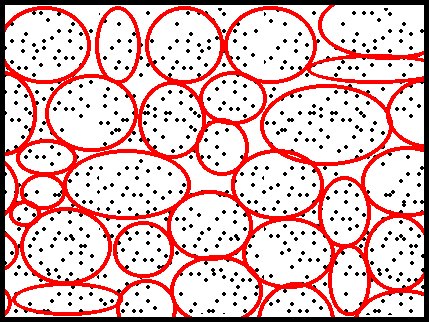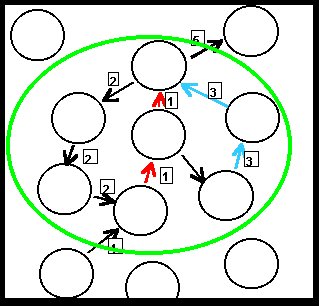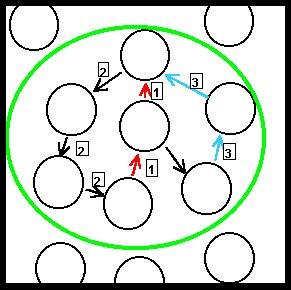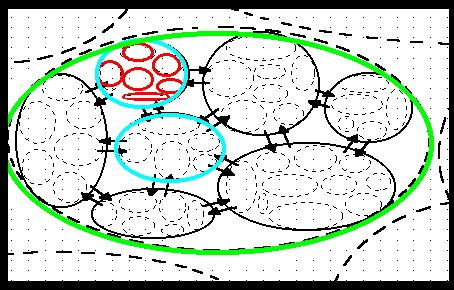Systems Theory
The
Systems Approach
The term "systems" is
derived from the Greek word "synistanai," which means
"to bring together or combine." The term has been used
for centuries. Components of the organizational concepts referred
to as the "systems approach" have been used to manage
armies and governments for millennia. However, it was not until
the Industrial Revolution of the 19th and 20th centuries that
formal recognition of the "systems" approach to management,
philosophy, and science emerged (Whitehead 1925, von Bertalanffy
1968). As the level of precision and efficiency demanded of technology,
science, and management increased the complexity of industrial
processes, it became increasingly necessary to develop a conceptual
basis to avoid being overwhelmed by complexity. The systems approach
emerged as scientists and philosophers identified common themes
in the approach to managing and organizing complex systems. Four
major concepts underlie the systems approach:
- Specialization: A system is divided into smaller components
allowing more specialized concentration on each component.
- Grouping: To avoid generating greater complexity
with increasing specialization, it becomes necessary to group
related disciplines or sub-disciplines.
- Coordination: As the components and subcomponents
of a system are grouped, it is necessary to coordinate the interactions
among groups.
- Emergent properties: Dividing a system into subsystems (groups
of component parts within the system), requires recognizing and
understanding the "emergent properties" of a system;
that is, recognizing why the system as a whole is greater than
the sum of its parts. For example, two forest stands may contain
the same tree species, but the spatial arrangement and size structure
of the individual trees will create different habitats for wildlife
species. In this case, an emergent property of each stand is
the wildlife habitat.
|
What
is a system?
The systems approach considers
two basic components: elements and processes. ELEMENTS are measurable
things that can be linked together. They are also called objects,
events, patterns, or structures. PROCESSES
change elements from one form to another. They may also be called
activities, relations, or functions. In a system the elements
or processes are grouped in order to reduce the complexity of
the system for conceptual or applied purposes. Depending on the
system's design, groups and the interfaces between groups can
be either elements or processes. Because elements or processes
are grouped, there is variation within each group. Understanding
the nature of this variation is central to the application of
systems theory to problem-solving. |

|
Ecosystems are composed of elements
and processes. (These are usually referred to as ecosystem structures
and functions or the patterns and processes of an ecosystem.)
As an example, the elements of a forest ecosystem might include
trees, shrubs, herbs, birds, and insects, while the processes
might include growth, mortality, decomposition, and disturbances.
Open
vs Closed Systems
|
Some systems are open with respect
to certain elements or processes (e.g., figure to the right).
The elements or processes can flow into or out of the system.
For example, an automobile engine is "open" with respect
to gasoline--gasoline flows in and exhaust (oxidized gasoline)
flows out. |
 |
|
Other systems are closed with
respect to certain elements or processes (e.g., figure to the
right). The elements or processes do not leave the system. For
example, an automobile engine is largely "closed" with
respect to lubricating oil--the oil does not leave the engine. |

|
Ecological systems are open systems
with respect to most elements and processes. They receive energy
and nutrient inputs from their physical environment and, at the
same time, cycle nutrients back out of the system. They are also
open to outside influences such as disturbances (e.g., hurricanes,
ice storms, fires, insect outbreaks).
|
Hierarchies
Most systems contain nested systems;
that is, subsystems within the system. Similarly, many systems
are subsystems of larger systems. |
 |
For example, the nested system
above right could represent:
atoms (black dots), molecules
(red circles), cells (blue), and organs (green);
leaves (black dots), trees
(red circles), stands (blue), and landscapes (green);
planets (black dots), solar
systems (red circles), galaxies (blue circle), and universes (green).
Nested systems can be considered
as a hierarchy of systems. Hierarchical (nested) systems contain
both parallel components (polygons of the same color, above) and
sequential components (polygons of different colors, above).
"At the higher levels, you
get a more abstract, encompassing view of the whole emerges, without
attention to the details of the components or parts. At the lower
level, you see a multitude of interacting parts but without understanding
how they are organized to form a whole (Principia
Cybernetica 1999)."
Attempting to measure, study,
or manage a system at a precision greater than the innate variation
among its components leads to meaningless measures. At the upper
levels of a hierarchical system, the amount of precision which
can be measured, studied, or managed declines for two reasons:
- The elements or processes in
parallel components of a system (e.g., two stands) are slightly
different; therefore, combining them at a broader level (e.g.,
landscape) increases the innate variation of the average component
(e.g., stand).
- The elements or processes in
sequential components of a system are dependent on each other;
therefore, variation in components become additive. For example,
size variation among trees within a stand means that there is
innate variation in the average tree size in a stand, and even
greater variation in the average tree size when stands are combined
into landscapes.
Moving information between levels
of a hierarchy requires time. The variation in time needed to
process different steps within a hierarchy can lead to innate
temporal lags or bottlenecks. These can be minimized by not trying
to consider a system with high precision from a single, central,
upper hierarchical level (e.g., centralized planning by governments
or regional models of ecosystems). Instead, such centralized levels
are useful for generalities which allow local variation, while
more precision is achieved through independent, parallel processes
at more localized levels.


